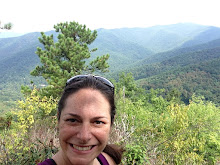As I read over my last post, I wondered if I'm making too much of a distinction between the ethnic groups here. The Tamils in Sri Lanka have certainly faced particular difficulties because of their ethnic background, and the "Indian" Tamil estate workers especially. But there are also many very poor Sinhalese villagers as well. And repeatedly during my stay here in Sri Lanka, people (of various backgrounds) have reminded me that they don't feel any anamosity towards the other ethnic group. They have repeatedly told me that they all want peace, and that they can all get along.
One of my Satyodaya field visits was to an area outside of Matale called Luckyland, also a former plantation area that is no longer functioning as a large tea estate. Now, it's more of a quiet hilltop village, where Tamils and Sinhalese live side by side. All of them say that their main problem is a lack of jobs in this remote area, now that the tea plantations have been divided up into small plots.
This village also faces problems from a lack of good infrastructure. Residents have to trek long distances up and down steep slopes in order to carry water to their homes. (I had a hard enough time climbing up the slopes to visit their houses without carrything anything). The main water source sits a 9-12 kilometer hike uphill from the homes, although there are a few smaller wells closer to the houses that they can use when it's not the dry season.
After Satyodaya helped the residents organize themselves into a Community People's Organization, the first thing the CPO decided to do was install a water supply system. They said they had been asking the government for help with this for nearly 20 years, with no results. So, they decided to do it themselves. I think they did manage to get some funding for it from the government with the collective voice of the CPO. And Satyodaya also helped to provide some of the initial funding. So, the villagers began the labor-intensive work of digging trenches for the 12 kilometers of pipes down from the water source, and mixing cement and installing spouts along the way at each house. After nearly a year of work, they are almost done and expect to have water supplied to each house within 2 weeks of my visit. Each household will pay a minimal fee each month to pay a caretaker, who will be responsible for maintenance.
When I visited on a Sunday afternoon, there were several villagers mixing cement near one house...men and women, Sinhalese and Tamils, working side by side. The majority of the villagers here are Sinhalese, but they elected a Tamil man as the president of their CPO. These hardworking, generous people seemed to have a strong sense of fellowship with one another. They also warmly welcomed me, and at each home I visited I was sent away with something - kitul (like hardened molasses) from their palm trees, jambu (a small red fruit) from their garden, papaya to take back to one of the Satyodaya staff who has been ill...
They may have a lot of poverty and structural problems to overcome in Luckyland, but their sense of community and shared identity is much stronger than in many much wealthier places.
Subscribe to:
Post Comments (Atom)

No comments:
Post a Comment